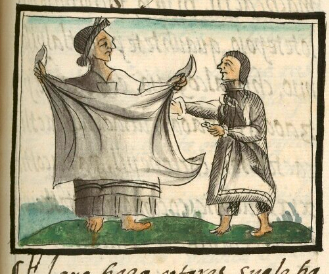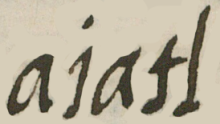ayatl (FCbk10f53r)
This iconographic example, featuring a cloak or blanket made of coarse fiber (ayatl), is included in this digital collection for the purpose of making comparisons with related hieroglyphs. The term selected for this example comes from text near the image in the Digital Florentine Codex. There is no gloss, per se. This example shows a woman holding a white, rectangular cloth by its top two corners. In the contextualizing image, a potential buyer on her right is a man wearing a cloak. The seller of ayatl is an ayanamacac, which also appears in the Nahuatl text. Both the cloth and the woman’s clothing have shading, which shows a European artistic influence. This is true, too, of the blue sky at the top and the green ground at the bottom of the “scene,” which also involve European influences. With regard to another matter, Anderson and Dibble use male pronouns, but the seller is clearly a woman. The description of the “capes” explains that they can be thick or thin, tight or loosely woven. Nettles and flowers can be woven into these cloths.
Stephanie Wood
Many examples of ayatl in this digital collection show involve flags or banners, but it is not really clear that the ayate fabric was used for making flags. The flags could easily be phonetic indicators for the -pan locative. Like the tilmatli (cloak) the ayatl often has its top corners pulled upward, which may reinforce that purpose.
Stephanie Wood
aiatl
ayatl
Stephanie Wood
1577
Jeff Haskett-Wood
telas, mantas, capas, textiles, rectángulos, ayate
aya(tl), a cloak or blanket made of coarse coarse cotton, maguey, or henequen fiber, https://nahuatl.wired-humanities.org/content/ayatl
-namacaqui (pl. -namacaque), a suffix referring to an occupation, often a merchant selling something; in the Florentine Codex, often written in the singular as -namacac, https://nahuatl.wired-humanities.org/content/namacaqui
la manta o el tilma de ayate
Stephanie Wood
Available at Digital Florentine Codex/Códice Florentino Digital, edited by Kim N. Richter and Alicia Maria Houtrouw, "Book 10: The People", fol. 53r, Getty Research Institute, 2023. https://florentinecodex.getty.edu/en/book/10/folio/53r/images/0 Accessed 10 September 2025.
Images of the digitized Florentine Codex are made available under the following Creative Commons license: CC BY-NC-ND (Attribution-NonCommercial-NoDerivs 4.0 International). For print-publication quality photos, please contact the Biblioteca Medicea Laurenziana ([email protected]). The Library of Congress has also published this manuscript, using the images of the World Digital Library copy. “The Library of Congress is unaware of any copyright or other restrictions in the World Digital Library Collection. Absent any such restrictions, these materials are free to use and reuse.”






